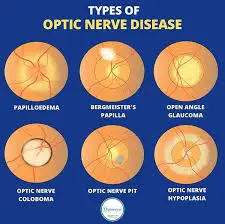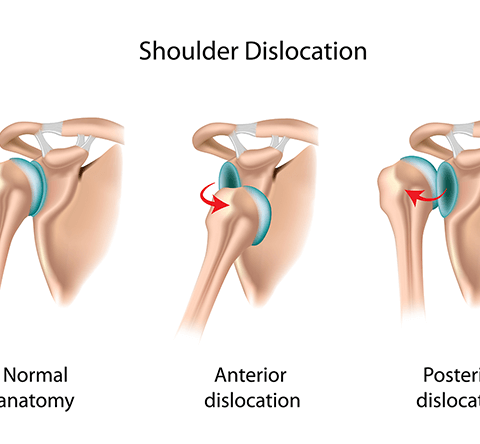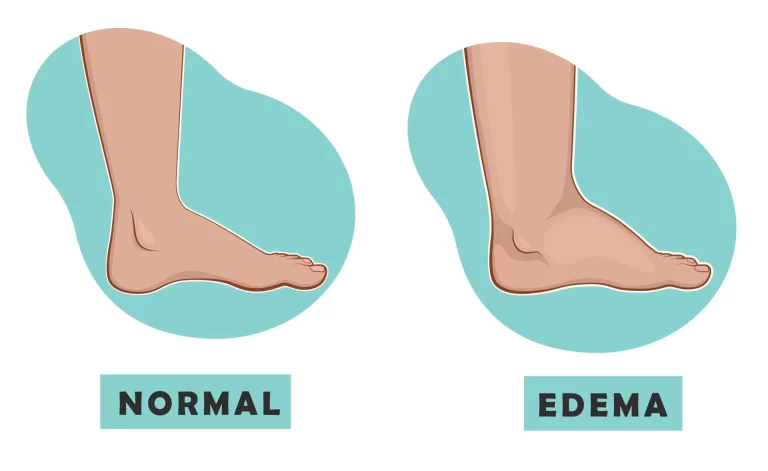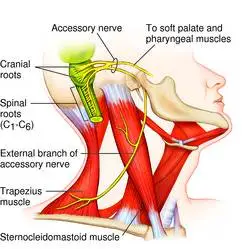Optic Nerve Disorders
Optic Nerve Disorders can lead to significant visual impairment or even blindness. These disorders encompass a wide range of conditions, including optic neuritis, optic nerve atrophy, optic nerve glioma, and various forms of ischemic optic neuropathy.
The optic nerve is a crucial component of the visual system, transmitting visual information from the retina to the brain.
Optic nerve disorders can disrupt vision because it is responsible for sending information from the eye to the brain. Optic nerve disorders can significantly lower a person’s quality of life. Optic nerve disorders can cause everything from total blindness to hazy vision, poor color vision, difficulty reading or identifying faces, and vision loss.
Depending on the nature and severity of the patient’s ailment, the diagnosis and course of therapy must be customized for each patient. Commonly, this includes counseling, specialized rehabilitation programs, medicine, or surgery.
Types Of Optic Nerve Disorders
Optic Neuropathies
- This type of illness affects the optic nerve, causing aberrant nerve function and possibly visual atrophy. They could be inherited, the result of drugs or chemicals, or the result of trauma. In most cases, they don’t result in optic nerve edema or inflammation.
- Optic nerve damage can result in pain and visual issues, usually affecting just one eye. When moving the affected eye, a person may experience pain or visual loss limited to the center of their field of vision (scotoma).
Optic neuritis
- This is the term for inflammation of the optic nerve resulting from either an infection within the body or from unknown causes, or a loss of nerve sheath coating (demyelination), as observed in multiple sclerosis.
- The primary signs and symptoms of optic neuritis are discomfort and visual abnormalities, the same as other optic neuropathies. If an overactive immune system is causing the inflammation of the nerves, the doctor might suggest corticosteroids or other drugs to treat it.
- Within weeks or months, symptoms start to get better, and within a year, the majority of optic neuritis patients fully recover on their own. There is a connection between multiple sclerosis (MS) and this illness. According to studies, over 50% of patients with optic neuritis go on to acquire multiple sclerosis during the next 15 years.
- When a patient has optic neuritis, the physician may recommend an MRI to determine the patient’s risk of developing multiple sclerosis. If so, some medications can help stop the disease’s course or perhaps stop it from starting.
Ischemic Optic Neuropathy
- The optic nerve experiences a short period of blood loss due to a minor blood vessel blockage, which is similar to a mini-stroke known as ischemic optic neuropathy.
Papilledema
- Papilledema is the enlargement of the optic discs in both eyes as a result of increased intracranial or cerebral pressure. Papilledema can affect people of any age, color, ethnicity, or gender.
Optic atrophy
- This is an end-stage optic nerve disorder in which the nerve thins out and becomes irreversibly injured as a result of several conditions, including the above-mentioned optic nerve diseases or conditions of neurology and neurosurgery.
Temporal Giant Cell Arteritis
- A condition known as giant cell arteritis, or temporal arteritis, affects the big and medium-sized arteries that run from the neck into the head. The illness may impact one eye’s vision. A dry cough, fever, headache, jaw pain, and issues with arm blood circulation are some other symptoms. Individuals who have giant cell arteritis may be susceptible to aneurysm development.
Chiasm Disorders
- Focusing, depth perception, and maintaining a proper field of vision can all be done with both eyes thanks to the optic chiasm, which is the point where the optic nerves of the left and right eyes meet.
- The most frequent cause of issues in the optic chiasm is difficulties with the blood arteries in the brain, including bleeding, although tumors and trauma can also bring on chiasm diseases.
- The symptoms may be so severe as to impair a person’s ability to read, see, and navigate their environment. They can lose their ability to drive as a result of failing to see approaching cars or persons.
Disorders of Eye Movement
- Nerve disorders may impact the nerves encircling the eye as well as those regulating the pupil’s dilatation and contraction. Symptoms include double vision, nystagmus, oscillopsia, and pupillary abnormalities like anisocoria can be caused by such issues.
- A patient with these issues may require a thorough evaluation by the physician, especially if the symptoms are recent, as they may point to a more serious condition such as multiple sclerosis, head trauma, aneurysm, or tumor.
Temporary Vision Impairment
- Auras, a sign of migraine and other headaches, may be connected to momentary visual issues. A person may have visual, sensory, or motor symptoms during the aura phase, which may occur before the headache. Some symptoms include changed speech, numbness, hallucinations, weakening of the muscles, and impaired vision. A physician can assess a patient’s symptoms and assist in identifying the cause. Auras can often be addressed with migraine treatment.
Congenital and hereditary optic nerve malformations
- Atypical and deformed optic nerves can have functional importance from infancy. Congenital optic nerve abnormalities can cause a wide range of functional vision deficits and are not progressive. As part of an early diagnosis, any connection to a systemic or neurological illness should be ruled out.
- Common congenital appearances with mild functional effects include hypoplasia, tilted disc, optic pit, and optic nerve head tumors.
- Hereditary optic neuropathies are associated with progressive vision loss. Notable cases include dominant optic atrophy, Leber’s hereditary optic neuropathy, optic atrophy linked to neurologic or systemic disease, Wolfram syndrome (a juvenile-onset disease mellitus characterized by optic nerve atrophy, hearing loss, and neurodegeneration), and Costeff syndrome (optic nerve atrophy, delayed development, and movement disorders). In these situations, vision loss is frequently severe and linked to systemic or neurological disorders.
Acquired disorders of the optic nerve
- In addition to inherited and congenital abnormalities, there are other etiologies causing optic nerve disorders. A mixed-mechanism progressive optic neuropathy is glaucoma.
- In addition to cerebral space-occupying lesions, compressive, toxic/nutritional, traumatic, vascular, and inflammatory factors can induce non-glaucomatous optic nerve injury.
Compressive Optic Neuropathies
- Space-occupying lesions that interfere with the functioning of the optic nerve and retinal ganglion cells cause these diseases. Gliomas, meningiomas, hemangiomas, craniopharyngiomas, and pituitary adenomas are common neoplasias that can result in CON.
- Non-neoplastic causes of CON include ethmoid or sphenoid sinus mucocele, aneurysms, and thyroid eye disease. In the event of a chiasmal lesion, compression may transpire along any one of the four nerve segments, leading to either unilateral or bilateral nerve involvement.
Inflammatory Optic Neuropathy
- An acute inflammatory illness of the central nervous system that affects the optic nerve is referred to as optic neuritis (ON).
- An inflammatory onslaught that causes axonal damage and retinal ganglion cell death is the cause of demyelinating ON. It is the most prevalent kind of optic nerve inflammatory disease. A person with typical demyelinating ON is more likely to develop multiple sclerosis (MS) in the future. Optic neuritis is another common side effect of this illness.
Nutritionally-based, toxic optic neuropathy
- These illnesses are caused by either a protracted dietary deficit or toxic chemical exposure. Ingestion or inhalation of hazardous substances, along with the use of toxic drugs, can result in toxic neuropathy.
- The toxicity of medications varies with both dose and duration. The most common cause of toxic optic neuropathy is the antimycobacterial medication ethambutol. When ethanol is administered, methanol optic neuropathy presents with an acute clinical presentation. More frequently, accidentally consuming ethanol from home-distilled alcoholic beverages leads to neuropathy.
- A strong correlation has been shown between vitamin B12, folic acid, and copper deficits and nutritional ocular neuropathy. B12 deficits may be caused by pernicious anemia, nitrous oxide poisoning, and stomach conditions such as atrophic gastritis, history of gastric surgery, gastric malabsorption, and treatment for gastroesophageal reflux.
Optic neuropathy following trauma
- Damage to the optic nerves is the root cause of this type of optic neuropathy. The area of the optic nerve damaged determines the extent of visual loss. Traumatic optic neuropathy is divided into two categories: primary and secondary. When concussive forces are applied directly to the nerve, as occurs when the nerve’s portion is inside the optic canal, indirect injury may result.
- When direct injuries do occur, the affected nerve suffers instantaneous and frequently irreparable damage. One way that indirect injury might happen is when concussive forces are transferred straight to the nerve, as happens when the nerve’s part is inside the optic canal.
- Subsequent traumatic optic neuropathy is brought on by damage to the optic nerve after the traumatic event. Certain circumstances lead to a delay in vision loss. Many processes, such as vasospasm, edema, hemorrhage, and vascular compression leading to nerve necrosis and circulatory insufficiency, have been proposed to explain secondary damage.
Symptoms Of Optic Nerve Disorders
Symptoms of optic nerve disorders include:
- Blurring of vision
- Diminished vision
- Momentary loss of vision
- Absence of the visual field
- Discomfort behind the eyeball when moving the eyes
- Diminished ability to perceive color
- Diminished perception of brightness
Causes Of Optic Nerve Disorders
- Genetic: Optic nerve disorders are frequently inherited, meaning that a gene abnormality causes them to run in the family.
- Diseases of the nervous system: illnesses include stroke, Parkinson’s, Alzheimer’s, and multiple sclerosis, among others.
- Brain tumors and Brain infections.
- Trauma: Head injuries can cause atrophy and optic neuropathy.
Risk Factors Of Optic Nerve Disorders
- Family background
- Diabetes
- High blood pressure
- Low blood pressure
- Elevated lipids
- Being overweight
- Multiple sclerosis
- Neurological conditions
- Neurosurgery
- Head Injury
- Disorders of the eyes include glaucoma and uveitis
- Sleep Apnea
Diagnosis for Optic Nerve Disorders
To diagnose optic nerve illnesses accurately, a thorough eye examination and specialized testing are necessary. Among them are:
- Testing visual acuity: A vision chart is used to test the vision.
- Dilated eye exam to see the retina and optic nerve.
- Color vision testing: To find out if there is decreased color perception, this is done using specialized charts, books, or computer software.
- Contrast sensitivity testing measures an individual’s ability to see objects in low contrast by using specialized charts or computer software.
- Stereoacuity: With the aid of special glasses and booklets, this examination assesses the visual nerve and higher brain functions. The exam assesses a person’s ability to see in three dimensions with both eyes working simultaneously.
- Visual field tests, also known as perimetry: This test uses a specialized machine to measure the area between your eyes that you can see. The eye’s field of vision narrows or changes in several optic nerve disorders.
- Visual evoked response/electrophysiology: This assesses the optic nerve’s capacity to communicate with the brain. Electrodes that detect electric signals when an intense flash of light or patterned stimuli is provided to the eye are placed close to the forehead and the back of the skull for the test.
- Optic nerve imaging: To obtain an extremely detailed view of the optic nerve, this is accomplished with the aid of tools like optical coherence tomography.
- Brain imaging: In many cases of optic nerve illnesses, a definite diagnosis can be made with the use of an MRI or CT scan of the brain and eyes.
Treatment of Optic Nerve Disorders
- Lifestyle changes: It’s critical to manage diabetes, hypertension, high blood pressure, and obesity with both medication and lifestyle changes.
- Medical therapy: For disorders of the optic nerve, such as optic neuritis or traumatic optic neuropathy, intravenous steroids are the preferred course of action. Aspirin for ischemic neuropathy and nerve tonics or multivitamin supplements are among the additional medications utilized.
- Surgical therapy: Optic nerve decompression for traumatic optic neuropathy or optic nerve sheath fenestration for idiopathic intracranial hypertension are two examples of surgical therapy.
Prevention for the Optic Nerve Disorders
Regular eye exams and the management of risk factors such as diabetes, high blood pressure, low blood pressure, high cholesterol, obesity, and sleep apnea can help avoid optic nerve disorders. Other preventive measures include:
- Keep up a healthy way of living:
- Keep your eyes safe from harm.
- Make time for routine eye checkups.
- Handle underlying medical issues
- Give up smoking
- Manage your blood pressure.
Summary
Relatively common clinical findings, optic nerve diseases can occur from a variety of congenital, inherited, and acquired conditions. A thorough history, a group of clinical observations, the outcomes of structural and functional diagnostic investigations, and knowledge of a chronic or acute pattern of presentation enable an accurate diagnosis and course of therapy. Accurately diagnosing optic neuropathies can preserve lives in addition to vision.
FAQs
Where is the location of the optic nerve?
The origin of the optic nerve is the optic disk, a structure situated at the rear of the eye with a diameter of 1.5 mm (0.06 inch). As ganglion cell output fibers, or axons, leave the eye, they converge to form the optic disk.
Can optic nerve disorders cause blindness?
A disorder known as atrophy of the optic nerve results from long-term harm to optic nerve fibers caused by a variety of factors. Blindness and other irreversible visual problems can result from optic atrophy.
Are your eyes affected by nerve damage?
Your eye sends visual data to your brain through the optic nerve. When a nerve gets unexpectedly irritated, it may enlarge. Nerve fibers may sustain harm from the edema. This may result in short or long-term visual loss.
Can stress damage an optic nerve?
Anxiety and stress can have a long-term impact on optic nerve damage. These effects may be reduced and the development of eye illness slowed down with the use of mindfulness meditation, mental health therapy, and other stress-reduction techniques.
Which disorders have the potential to harm the optic nerve?
The optic nerve can be impacted by a wide range of conditions, such as
Optic nerve tumors.
Glaucoma.
Idiopathic intracranial hypertension.
Optic neuromyelitis.
Atrophy of the optic nerve.
The drusen optic nerve.
Pit of the optic nerve.
Optic nerve injury.
References
- Neuro-Visual disorders. (2021, August 8). Johns Hopkins Medicine. https://www.hopkinsmedicine.org/health/conditions-and-diseases/neurovisual-disorders
- Chen, J. J. (2022, October 11). Overview of optic nerve disorders. Merck Manual Consumer Version. https://www.merckmanuals.com/home/eye-disorders/optic-nerve-disorders/overview-of-optic-nerve-disorders
- OD Optic Nerve Disorders: How they manifest and what they mean. Review of Optometry. https://www.revieweducationgroup.com/ce/optic-nerve-disorders-how-they-manifest-and-what-they-mean
- Optic nerve disorders. (n.d.). Duke Health. https://www.dukehealth.org/treatments/eye-care/optic-nerve-disorders
- Dr. Digvijay Singh. (2023, April 20). Optic Nerve Disease – eye specialist, Treatments, types and symptoms. – 9811664647. https://drdigvijaysingh.com/eye-diseases/optic-nerve-diseases/







